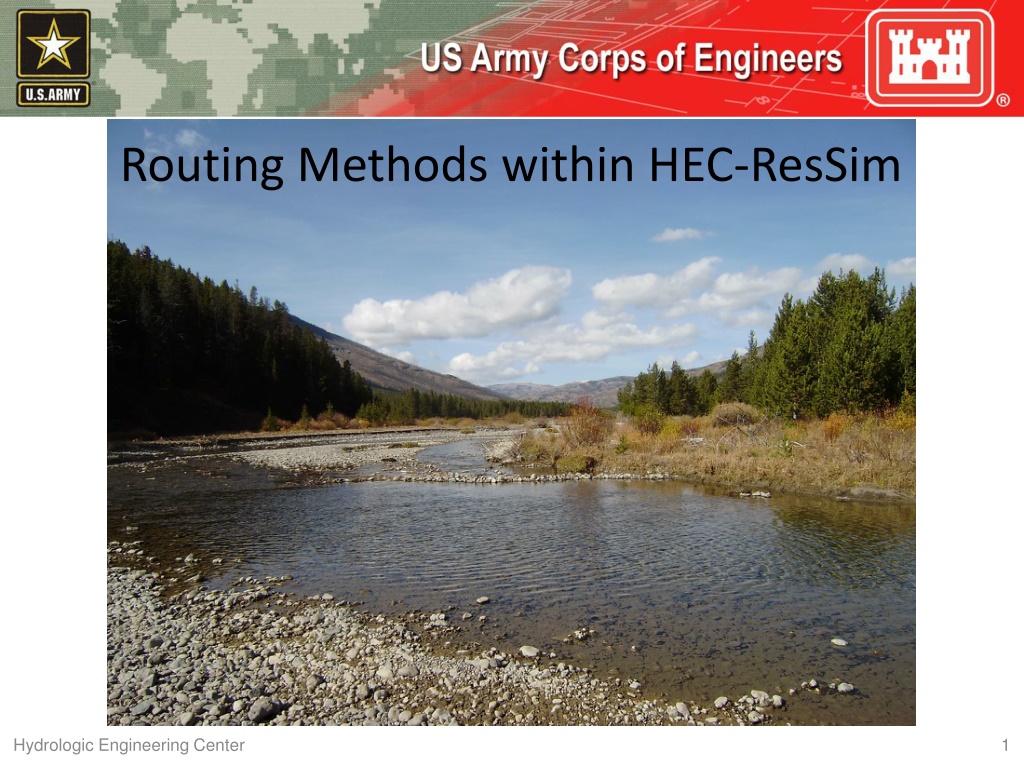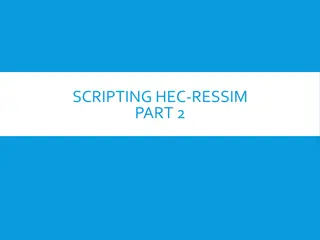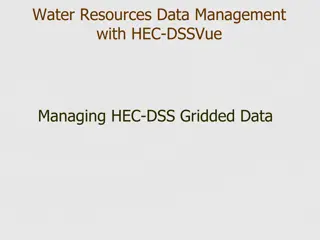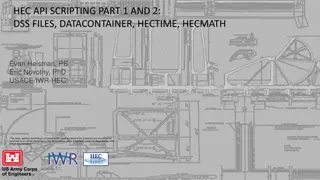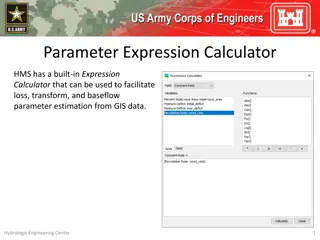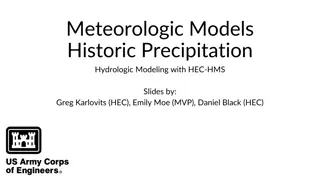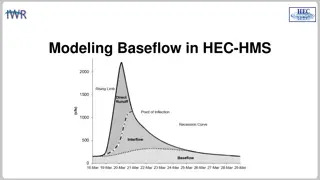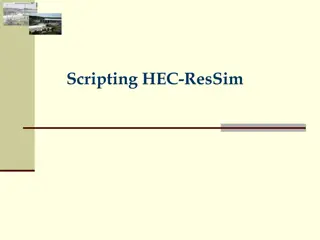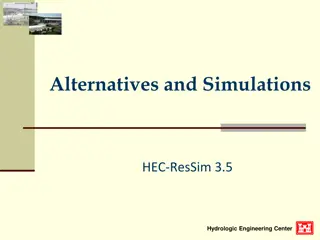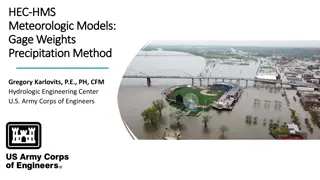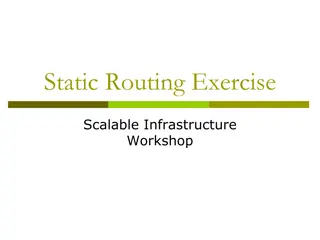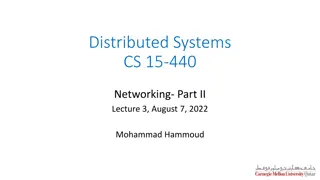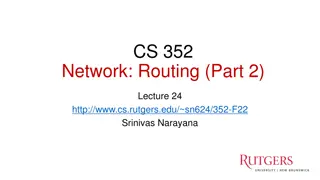Understanding Routing Methods in Hydrologic Engineering Center (HEC-ResSim)
Explore the differences between hydrologic and hydraulic routing, learn about open channel flow processes, and delve into channel routing within HEC-ResSim. Discover various reach routing methods, parameter estimation techniques, and calibration approaches. Dive into the Muskingum method and its application in accommodating the relationship between storage and outflow in rivers.
Download Presentation

Please find below an Image/Link to download the presentation.
The content on the website is provided AS IS for your information and personal use only. It may not be sold, licensed, or shared on other websites without obtaining consent from the author. Download presentation by click this link. If you encounter any issues during the download, it is possible that the publisher has removed the file from their server.
E N D
Presentation Transcript
Routing Methods within HEC-ResSim Hydrologic Engineering Center 1
Objectives Provide an overview of open channel flow processes and common applications. Discuss how hydrologic routing differs from hydraulic routing. Describe channel routing within HEC-ResSim Show the available reach routing methods and Highlight a few methods in more detail Parameter estimation Advantages and Disadvantages Calibration Techniques Hydrologic Engineering Center 2
Overland vs Open Channel Flow Hydrologic Engineering Center 3
Reach Routing Travel Time 7,000 6,000 Attenuation Water entering storage 5,000 Inflow Hydrograph at Point A Flow Rate (cfs) 4,000 Routed Hydrograph at Point B Water leaving storage 3,000 2,000 1,000 0 0 4 8 12 16 20 24 Time (hrs) Hydrologic Engineering Center 4
Hydraulic and Hydrologic Routing Hydraulic Routing Based on Solutions of Partial Differential Eqns. St. Venant equations (Dynamic Wave Eqns.) Continuity Equation Momentum Equation Hydrologic Routing Continuity Equation Momentum Equation or Storage-Discharge Relationship Hydrologic Engineering Center 5
St. Venant Equations AV y x y t Continuity + + = VB B q x 1 y V V V Momentum = S S f o x g x g t Hydrologic Engineering Center 6
Available Routing Methods Coefficient Muskingum Muskingum-Cunge 8-pt Channel Prismatic Channel Modified Puls SSARR Working R&D Variable Lag and K Hydrologic Engineering Center 7
Muskingum Method Developed to accommodate the looped relationship between storage and outflow that exists in rivers Relationship between storage and discharge at the outlet is not a unique relationship, it is looped For a more in-depth discussion of this method, see: https://youtu.be/AhifqyHKliY Hydrologic Engineering Center 8
Example Inflow Outflow Hydrologic Engineering Center 9
Parameter Estimation K K is equivalent to travel time through the reach Can estimate in three ways: Use known hydrograph data Compare flow length to a flood wave velocity Inflow Outflow ????? ???????????? ? = Use regional regression equations Hydrologic Engineering Center 10
Parameter Estimation K Compare flow length to a flood wave velocity Manning s Equation Kleitz Seddon Law Flood wave velocity can be approximated from the channel and rating curve 1 ?????= ??? ???? ????? ?? ?????? ????? Hydrologic Engineering Center 11
Parameter Estimation X Affects attenuation Dimensionless coefficient Lacks a strong physical meaning Limited to bound 0.0 to 0.5 When X = 0: Storage is only a function of outflow Maximum attenuation When X = 0.5: Equal weight to inflow and outflow No attenuation; only translation Start with 0.25 and calibrate Inflow Outflow; X = 0.4 Outflow; X = 0.1 Hydrologic Engineering Center 12
Parameter Estimation - Number of Subreaches Affects attenuation Constraint between K and computational interval, t Ideally, t = K ? ? Number of Subreaches = However, t cannot be less than 2*K*X Can be treated as a calibration parameter Inflow Outflow; # of subreaches = 20 Outflow; # of subreaches = 10 Hydrologic Engineering Center 13
Advantages "Mature" method that has been used successfully in thousands of studies throughout the U.S. Easy to set up and use. Method is parsimonious; it includes only a few parameters necessary to explain the variation of runoff volume. Disadvantages Method may be too simple to accurately predict flood wave translation and attenuation. Only appropriate for use in moderately steep streams (bed slopes > 2 ft/mi). Cannot simulate variable translation and attenuation. Cannot simulate backwater effects or impacts of hydraulic structures. Example Application Hydrologic Engineering Center 14
Muskingum-Cunge Method Builds upon the Muskingum method Within the Muskingum method, the X parameter (i.e. attenuation) is not physically based Cunge set numerical diffusion equal to physical diffusion This allowed for parameters to be physically-based as well as improving accuracy and applicability For a more in-depth discussion of this method, see: https://youtu.be/aUdExHpePOY Hydrologic Engineering Center 15
Example Inflow Outflow Hydrologic Engineering Center 16
Parameter Estimation Reach Length and Friction Slope Compute reach characteristics Parameters | Characteristics | Reach Friction slope can be initially estimated using bed slope If slope varies significantly, it may be necessary to use multiple reaches with different slopes Hydrologic Engineering Center 17
Parameter Estimation Mannings Roughness Average value for the whole reach Estimate using reference streams or through calibration Bayou de Loutre near Farmerville, LA Computed roughness: n = 0.11 Depth of flow: 3.6 ft Hydrologic Engineering Center 18
Parameter Estimation Cross Section Shape Three shapes: Eight point Trapezoidal Circular Estimate parameters using GIS information When using Eight Point shape: Bank points are always the 3rd and 6th points Left/Channel/Right Manning s roughness changes at these points Hydrologic Engineering Center 19
Advantages Similar to advantages of the Muskingum method. Predicted values are in accordance with open channel flow theory. Parameters can be estimated using measurable channel characteristics. Can use cross-section shapes that include overbank areas. Good for ungaged reaches. Disadvantages Only appropriate for use in moderately steep streams (bed slopes > 2 ft/mi). Cannot simulate backwater effects or impacts of hydraulic structures. Method is less parsimonious than Muskingum; it requires many more parameters. Example Application Hydrologic Engineering Center 20
Modified Puls Method A unique relationship between storage and outflow of a reservoir (or channel) can be developed Solves the continuity equation over a time step (dt). Written as: + + O O I I S S = 1 2 1 2 2 1 2 2 dt Two unknowns O2 and S2 Use storage-discharge curve to solve Hydrologic Engineering Center 21
Modified Puls Method Relationship between storage and discharge at the outlet is not a unique relationship, it is looped (hysteresis) Hydrologic Engineering Center 22
Modified Puls Method Model the reach as a cascade of level pools Hydrologic Engineering Center 23
Example Inflow Outflow Hydrologic Engineering Center 24
Parameter Estimation Storage-Outflow Curves Steady-flow profile computations (Best) Observed water surface profiles Normal-depth computations Observed inflow and outflow hydrographs Optimization (calibration) techniques using observed inflow and outflow hydrographs Hydrologic Engineering Center 25
Parameter Estimation Storage-Outflow Curves Example from steady flow profiles Hydrologic Engineering Center 26
Advantages Can simulate backwater effects and impacts of hydraulic structures. Can be used to produce accurate results within flat streams (bed slopes < 2 ft/mi). Disadvantages Requires hydraulic simulations to derive accurate storage vs. outflow relationships; consequently, this method can be difficult to parameterize and calibrate. Hydrologic Engineering Center 27
Calibration Techniques For all hydrologic routing methods: First, match rising limb of hydrograph Then, match peak discharge Finally, iterate to match rising limb, peak, and receding limb as best as possible Use multiple statistical metrics Nash-Sutcliffe Efficiency Ratio of the Root Mean Square Error to the Standard Deviation Percent Bias R2 Inflow Outflow Obs. Flow Hydrologic Engineering Center 28
Review Discuss how hydrologic routing differs from hydraulic routing due to simplifications Seven hydrologic routing methods are available within HEC-ResSim Detailed the Muskingum, Muskingum-Cunge, and Modified Puls methods Presented parameter estimation techniques and advantages/disadvantages for each method Briefly discussed calibration techniques Hydrologic Engineering Center 29
